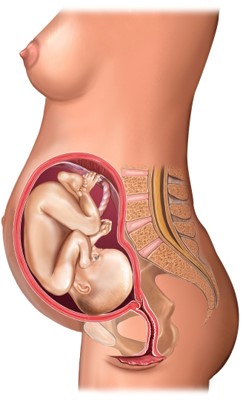
by Tanya Baca, CNM. Midwife at Virginia Complete Care for Women
The umbilical cord connects the fetus to the placenta, an organ that removes wastes and provides nutrition and oxygen to the fetus. The cord comes out of the fetus’ navel (belly button). After a baby is delivered, the cord is clamped and cut, but a small piece remains attached to the baby’s navel until it dries up and falls off.
Delayed cord clamping (DCC) refers to prolonging the period of time between a baby’s birth and clamping his or her umbilical cord. Instead of clamping in the first 15-20 seconds after birth, delayed clamping happens between 60 seconds and 5 minutes. There are benefits of delayed cord clamping to both you and your baby, they are described below:
Fetus with Umbilical Cord in Utero

Copyright© Nucleus Medical Media, Inc
Benefits of Delayed Cord Clamping
Since the 1960s, standard practice in the United States has been to clamp the umbilical cord within 15-20 seconds of birth because it was believed to lower the incidence of postpartum bleeding. Even after research showed no correlation between cord cutting and maternal hemorrhaging, the practice continued. Today, the American College of Obstetricians and Gynecologists (ACOG) recommends that providers wait a minimum of 30 to 60 seconds before clamping the cord. International researchers have shown some meaningful benefit to both preterm and full term babies:
- In preterm infants (those born from 24 weeks to 36 weeks gestation) DCC from 30 seconds to a maximum of 180 seconds resulted in an extra 30% blood volume which, has a significant benefit in improved circulation. There is up to 60% more iron-rich red blood cell volume, decreased need for blood transfusions, and lower incidence of necrotizing enterocolitis and intraventricular hemorrhaging (ACOG, 2017).
- In both preterm and full term infants who experience DCC there are increased iron stores that continue to be seen up to 12 months of age which, reflect the prevention of and decreased incidence of iron deficiency (ACOG, 2017). We know that healthy brain development correlates to the iron stores in a baby’s blood so; DCC can assist in favorable developmental outcomes. The Journal of American Medicine (JAMA) also found a small increase in the neurological development of young children who had DCC at birth.
- Delayed umbilical cord clamping has not been found to increase the risk of postpartum hemorrhage (ACOG, 2017).
As Dr. Heike Rabe, a neonatologist specializing in related research in the United Kingdom, states, “There is growing evidence from a number of studies that all infants, those born at term and those born early, benefit from receiving extra blood from the placenta at birth. The extra blood at birth helps the baby to cope better with the transition from life in the womb, where everything is provided for them by the placenta and the mother, to the outside world. Their lungs get more blood so that the exchange of oxygen into the blood can take place smoothly.”
Some studies have found that boys whose cords were cut at least 3 minutes after birth had better fine motor and social skills at age 4, though the same average IQ, when compared to those whose cords were cut earlier. It is believed that estrogen levels in the womb may provide added protection to girls.
Possible side effects of Delayed Cord Clamping
While the benefits of delaying cord clamping appear to far outweigh the detriments, there may be a very slight increase, less than 2%, in the incidence of jaundice that requires phototherapy in full term infants who had DCC. As a result, healthcare providers should be prepared to monitor and treat neonatal jaundice as needed.
Additionally, DCC can be incompatible with cord blood banking because there is not enough blood left in the cord to bank. That being said, some argue that there is a significant benefit to the nutrient rich stem cells being passed on to the baby at birth as the result of a delay in cutting their cord.
What is the recommended amount of time to delay cord clamping?
While the exact timing of DCC remains a topic of some debate, the following organizations all recommend some delay for both vaginal and caesarean births:
- American College of Obstetricians and Gynecologists (ACOG): Recommends waiting at least 30 to 60 seconds before clamping the cord. "While there are various recommendations regarding optimal timing for delayed umbilical cord clamping, there has been increased evidence that shows that the practice in and of itself has clear health benefits for both preterm and term infants," says Dr. Maria Mascola, lead author of the updated ACOG guidelines. "And, in most cases, this does not interfere with early care, including drying and stimulating for the first breath and immediate skin-to-skin contact."
- American College of Nurse-Midwives (ACNM): Recommends DCC for up to five minutes when the newborn is placed skin-to-skin with mom and up to two minutes if the newborn is placed and or below the level of the mothers’ vaginal introitus (opening) for term newborns (ACNM, 2014). They recommend in their position statement that preterm newborns should have 30 to 60 seconds of DCC.
- World Health Organization (WHO): Recommends late cord clamping performed 1 to 3 minutes after birth for all births while also initiating simultaneous essential newborn care. The cord should only be cut prior to 1 minute after birth if it is necessary to resuscitate the infant.
- Royal College of Midwives: recommends DCC at a minimum of 1 minute and ideally between 3 to 5 minutes postpartum.
Schedule an appointment with Tanya Baca, CNM at Virginia Complete Care for Women
Sources:
American College of Obstetricians and Gynecologists (ACOG)
World Health Organization (WHO)
Royal College of Midwives
American Pregnancy Association
Journal of American Medical Association (JAMA)